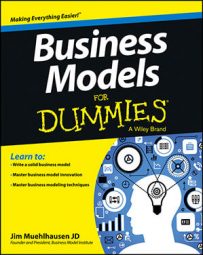The goal of any great business model is to have a high-profit product that customers want to buy. A highly marketable product is traditionally described as having a unique selling proposition. Whole Foods offers only healthy choices in its stores. Domino’s Pizza grew rapidly because of its super-fast delivery. UGG boots are not only fashionable but also allow you to walk comfortably without socks. These are all unique selling propositions.
Your product also needs a unique value proposition. Value is what the product does for customers that they’re prepared to pay you for — not its features. A product can have unique features, but do they benefit the customer, and is the customer prepared to pay for them?
Recently, minivan manufacturers decided that more cup holders are better. Some minivans offer a dozen or more cup holders. This feature is unique and offers a unique selling proposition. However, if the customer doesn’t value the cup holders, the value proposition is weak. In order to create the best possible business model, you must create the right combination of features and value.
Rosser Reeves was the author of the phrase unique selling proposition, or USP, which is a unique message about your business versus the competition. The USP is a marketing concept that was first proposed as a theory to understand a pattern in successful advertising campaigns in the early 1940s.
The theory states that campaigns made unique propositions to the customer, and this unique proposition convinced them to switch brands. Put another way, a USP is why a customer should care about your brand.
What’s tricky about a USP is that being unique is easy. Simply pick something obscure like raw octopus ice cream and, boom, you’re unique. However, you must be unique and attract a large number of profitable customers. UGG boots started as a small, unique market for sheepskin boots. This unique niche caught fire and UGG now sells millions each year.
Typically, market winners start off with a few loyal customers that love the value proposition. Eventually the value proposition, which was targeted to the loyal few, grows beyond expectations and becomes a market winner. The trick is to find the loyal and fanatical first customers. You can’t be all things to all people, so don’t try. If your product doesn’t create rabid fans, you probably don’t have a strong USP.
Defining your USP means examining your business in detail; hence, you may start with a freeform brainstorming session, and go over these main content areas:
Audience: Who is your ideal customer? Be as specific as possible, and don’t be afraid to exclude people. (You may even think about who isn’t in your audience.)
Problem: What problem do you solve for your ideal customer? Ideally, your product solves a specific problem that other products can’t solve. What pain are you eliminating? How is your customer better off after working with you or buying your product versus the alternatives?
Uniqueness: What sets you apart from others? Better yet, what meaningfully sets you apart? A USP of yoga shoes for women meaningfully sets you apart from other athletic shoes. A USP of athletic shoes for teenage women/girls probably doesn’t.
You can differentiate yourself in thousands of ways: service, range, experience, technique, guarantee, features, and so on. Focus on a handful of things that really make you one-of-a-kind — things that make a tangible difference to your audience.
A great USP comes from a deep understanding of who your customers are, what they want, what they value, and what motivates them. It should also cause your prospects to crave your product or service. It should cause them to see almost instantly that they’d be foolish not to investigate your company and your product. You’ll likely have a different USP for each product or service you offer.
Why is the USP so important? Think about it this way: If you can’t differentiate yourself from the hundreds or thousands of other choices out there, how do you expect your customer to do it?
This list shows you some good examples of products with a clear USP and tagline:
BMW: The Ultimate Driving Machine
Dawn Dishwashing Liquid: Gets grease out of your way
Domino’s Pizza: You get fresh, hot pizza delivered to your door in 30 minutes or less — or it’s free
FedEx: When it absolutely, positively has to get there overnight
MetLife: Get Met. It Pays.
M&M’s: Melts in your mouth, not in your hand
Target: Expect more. Pay less.
Walmart: Everyday low prices
When you’re creating your USP, don’t forget the old saying, “Price, quality, service: Pick any two.” You can’t be all things to all people. Starbucks can’t deliver the highest quality coffee with expert baristas at the same price as McDonald’s coffee.
By the same token, you won’t get the same shopping experience at Walmart that you get at Nordstrom’s. You’re far better off to excel at something than be acceptable at everything. USPs are about being exceptional at something — anything.

